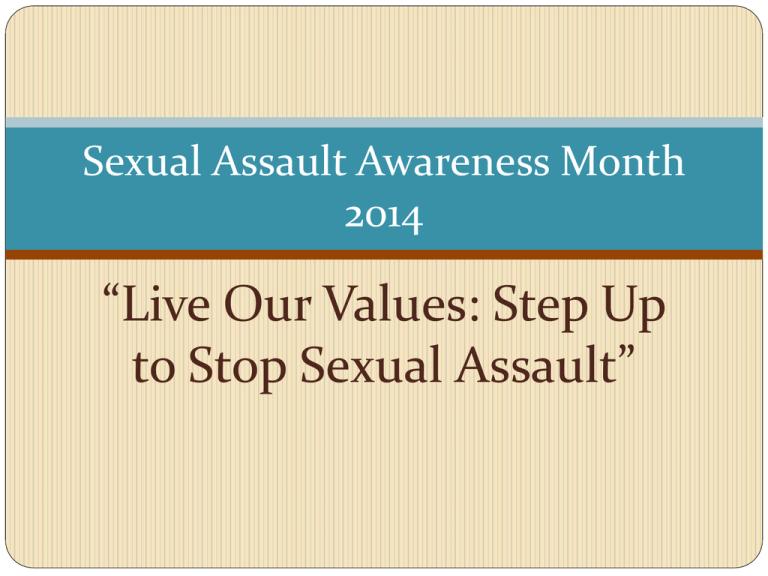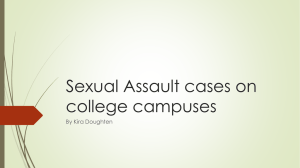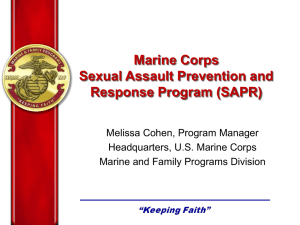
Sexual Assault Awareness Month
2014
“Live Our Values: Step Up
to Stop Sexual Assault”
Sexual Assault Awareness Month
“This April, the Department
observes the tenth Sexual Assault
Awareness Month with the theme
Live Our Values: Step Up to Stop
Sexual Assault. Sexual assault is
a crime and can only be stopped
when everyone understands we all
have a role in combating it.”
—Jessica L. Wright
Acting Under Secretary of Defense for
Personnel and Readiness
2
Sexual Assault Awareness Month
Sexual Assault Awareness Month
(SAAM) is recognized across the country
by both civilian and military
communities.
SAAM offers a unique opportunity to
build on existing momentum to fight
this crime and ensure all Service
Members are treated with dignity and
respect.
3
Sexual Assault Awareness Month
SAAM also provides organizations an annual
opportunity to highlight Department of Defense
(DoD) and Service initiatives addressing sexual
assault prevention and response.
4
DoD Sexual Assault Definition
Sexual Assault is defined as: Intentional sexual
contact characterized by the use of force, threats,
intimidation, or abuse of authority, or when the
victim does not or cannot consent.
Sexual assault includes a broad category of sexual
offenses consisting of the following specific UCMJ
offenses: rape, sexual assault, aggravated sexual
contact, abusive sexual contact, forcible sodomy, or
attempts to commit these offenses.
It can occur without regard to the gender, spousal
relationship, or age of the victim.
5
Sexual Assault Awareness Month
The 2014 Sexual Assault Awareness Month theme
is “Live Our Values: Step Up to Stop Sexual
Assault.”
6
Live Our Values…
• Every Service member, at every level in our military,
must adhere to and internalize Service values and
standards of behavior.
• Underpinning our entire program is the need for
every Service member—from new recruit to General
Officer – to live the core values of our profession:
integrity, trust, dignity, respect, fidelity, and courage.
• We continue to strive for an environment where
professional values, team commitment, and respect
define how we treat one another at every command,
workplace, and throughout our military community.
7
Step Up to…
Our entire DoD community has a critical role in
preventing and responding to sexual assault and must
intervene to reduce risk, stop inappropriate behavior,
and report crimes.
Bystander intervention is vital in helping to stop
unsafe and criminal behavior.
Service members’ decision to act could prevent
sexual assault.
8
Stop Sexual Assault
Our aim is to reduce, with a goal to eliminate, the
crime of sexual assault from the Armed Forces.
In order to prevent sexual assault, every member of
the DoD Community must be committed to
advancing an environment where sexist behaviors,
sexual harassment, and sexual assault are not
tolerated, condoned, or ignored.
Sexual assault is not only inappropriate behavior, it
is criminal behavior.
9
About SAPRO
Major General Jeffrey J. Snow
Director of the Sexual Assault
Prevention and Response Office
10
About SAPRO
SAPRO is the DoD’s single point of accountability
and oversight for sexual assault policy matters
and reports to the Under Secretary of Defense for
Personnel and Readiness.
11
About SAPRO
SAPRO is committed to the prevention of sexual
assault through training and education programs,
system accountability, and treatment and support of
victims.
The DoD requires that medical care and SAPR
services for victims are gender-responsive, culturally
competent, and recovery-oriented.
The DoD has implemented a comprehensive policy
to ensure the safety, dignity, and well-being of all
Service members.
12
Support Services
DoD Safe Helpline provides confidential, live,
one-on-one crisis intervention as part of victim
care. Available 24/7, users can click, call, or text
to access Safe Helpline services anonymously.
13
Support Services
Safe Helpline is owned by the DoD and operated by
the non-profit Rape, Abuse and Incest National
Network (RAINN), the nation's largest anti-sexual
violence organization.
Safe Helpline staff members have been trained on the
unique needs of those living and working in the DoD
community, and are knowledgeable about military
and civilian resources worldwide.
14
Support Services
Click: Logging on to
www.SafeHelpline.org allows
users to receive live, one-on-one,
confidential help with a trained
professional through a secure
instant-messaging format. The
website also provides vital
information about recovering from
and reporting sexual assault.
15
Sexual Assault Support
Call: Calling 877-995-5247 allows users to
speak with trained Safe Helpline staff for
personalized advice and support.
16
Sexual Assault Support
Safe Helpline staff can transfer callers directly to:
Installation-based Sexual Assault Response
Coordinators (SARCs)
On-call SAPR Victim Advocates
Civilian rape crisis centers
Military OneSource
National Suicide Prevention Lifeline
17
Support Services
Text: Texting a location
or zip code to 55-247 in the
U.S. and 202-470-5546
outside the U.S. allows users
to receive contact information for
the Sexual Assault Response
Coordinator, as well as medical,
legal, spiritual, and military police
personnel.
18
Sexual Assault Reporting
The aim of the DoD is to reduce, with the goal to
eliminate, the crime of sexual assault from the
Armed Forces.
The Department is committed to preventing sexual
assault in the military, and, if these crimes do occur,
to providing victims the care and support they need
to seek justice and heal from these traumatic events.
19
Sexual Assault Reporting
However, our biggest challenge in eliminating
sexual assault from the Armed Forces is the
underreporting of the crime. This affects the
ability to provide care to the victim, as well as
hindering the ability to prosecute the offender.
20
Sexual Assault Reporting
Research indicates that when sexual assault victims
receive care, system confidence builds, which
increases the likelihood victims will report to law
enforcement.
There are two types of reporting options: Restricted
(confidential) and Unrestricted.
21
Sexual Assault Reporting
Victims may report to a law enforcement agency,
SARC, Victim Advocate or medical professional.
Victims do not need to report to their commander.
22
Sexual Assault Reporting
In situations where a victim wants to participate in
the military justice process, a victim makes an
Unrestricted Report of sexual assault and both
command and law enforcement are notified of the
sexual assault.
23
Sexual Assault Reporting
Victims of sexual assault have the option of making
a confidential Restricted Report.
Restricted Reports are kept confidential.
• Law enforcement is not notified.
• The command is not notified with the name of the
sexual assault victim.
• The commander is given generic information “an
assault has occurred”, but no personal identifying
information is released.
24
Sexual Assault Reporting
With Restricted (confidential) Reporting a victim can
access care and services without participating in the
military justice system.
A Restricted Report can only be filed with 3
personnel: SARC, SAPR VA, or healthcare personnel.
However, when a Service member discloses the
matter to anyone other than these three personnel,
the information is not protected. The confidante to
whom the victim disclosed may in turn report the
incident to command and then a Restricted Report
might not be possible.
25
Myths and Facts: Understanding
Sexual Assault in the Military
26
Myths and Facts
Myth: The primary victims of sexual assault in the
military are women.
Fact: While rates of unwanted sexual contact are
higher for women than men, surveys estimate that
thousands of men are victimized every year; in the
DoD, sexual assault is a gender neutral crime.
27
Myths and Facts
Myth: There were 26,000 military women raped in
FY12.
Fact: The “26,000” estimate reflects not just rape,
but all forms of unwanted sexual contact—the
survey term for the full range of contact sex crimes
between adults that constitute “sexual assault”
under military law.
28
Myths and Facts
Myth: Prosecution is the best means of sexual
assault prevention.
Fact: Research shows many sex offenders choose to
believe that their behavior is not criminal or
punishable so many offenders are not deterred by
the prospect of punishment. Prevention is more
likely to be achieved when prosecution and
punishment are combined with interventions that
interfere with an offenders’ ability to complete a
criminal act.
29
Myths and Facts
Myth: If a victim has really been sexually assaulted,
he or she should be able to recall the event in great
detail.
Fact: Research shows that while victims can and do
store details about sexual assault in their memories,
trauma often interferes with the encoding and recall
of those memories. As a result, victims’ recall about
an incident may appear disorganized or incomplete,
which is incorrectly interpreted as being deceitful.
Use of alcohol at the time of the incident increases
memory problems.
30
Myths and Facts
Myth: Most sexual assault allegations are false.
Fact: The best, scientifically-sound, civilian research
shows that between 2 percent to 8 percent of sexual
assault allegations turn out to be false— meaning no
sexual assault was attempted or completed. This
means that there is a 92 percent to 98 percent
chance that the victim is telling the truth.
31
Sexual Assault Awareness Month
“We need cultural change where every
Service member is treated with dignity
and respect, where all allegations of
inappropriate behavior are treated with
seriousness, where victims’ privacy is
protected, where bystanders are
motivated to intervene, and where
offenders know that they will be held
accountable by strong and effective
systems of justice.”
— Secretary of Defense
Chuck Hagel
32
The Sexual Assault Prevention Response
Office (SAPRO)
and
The Defense Equal Opportunity
Management Institute,
April 2014
All photographs are public domain and are from
various sources, as cited.
Dawn W. Smith,
Senior Writer
DEOMI Research Directorate
33





